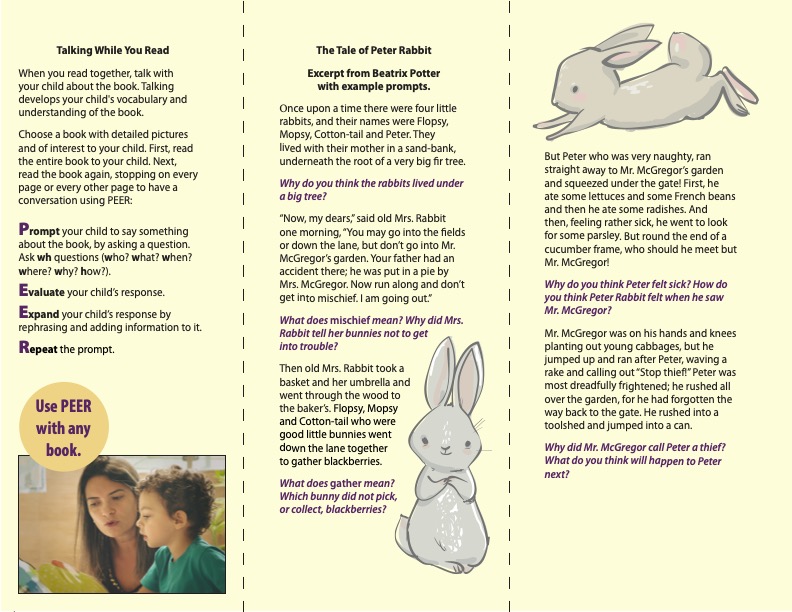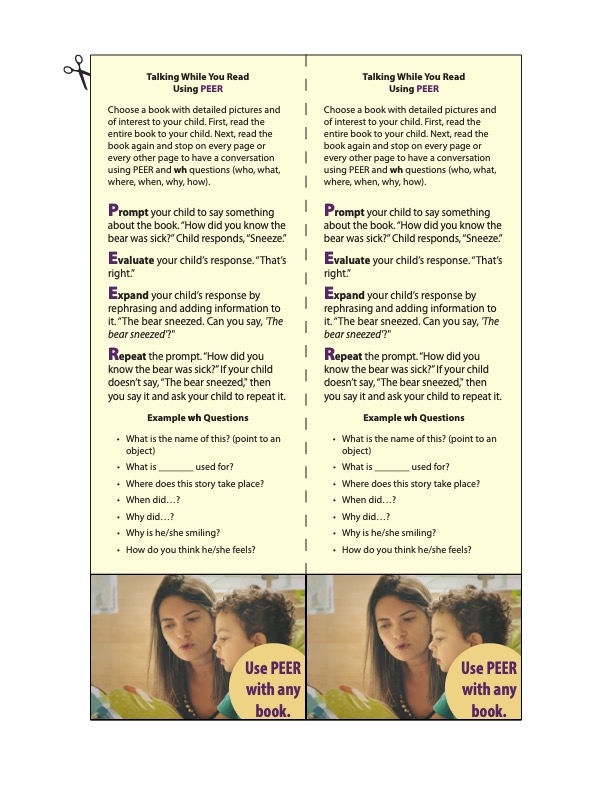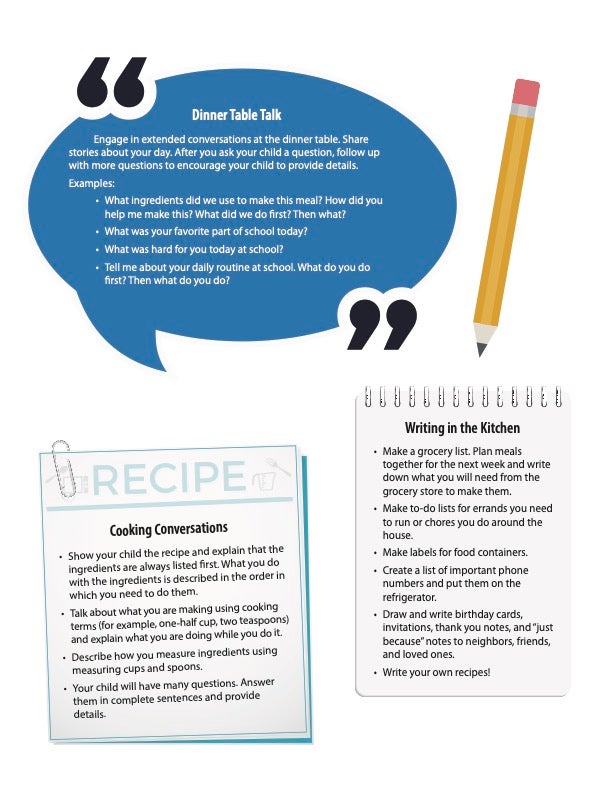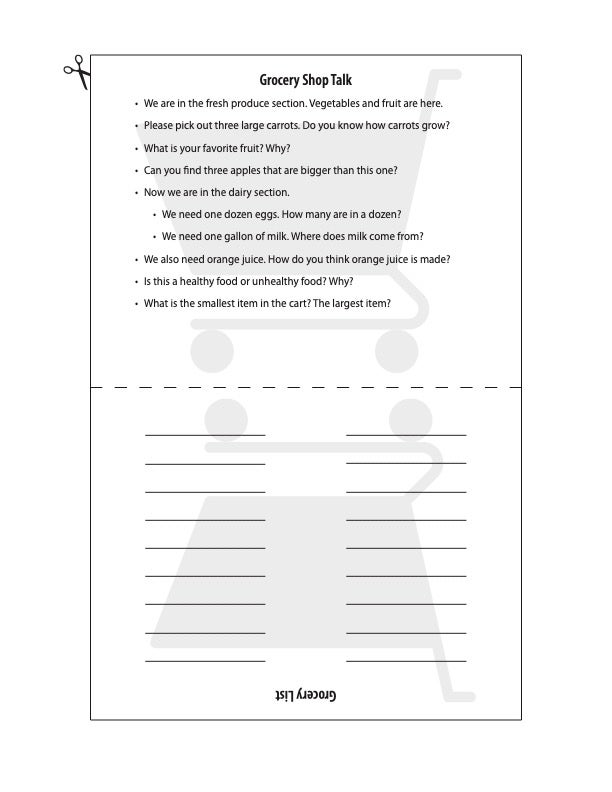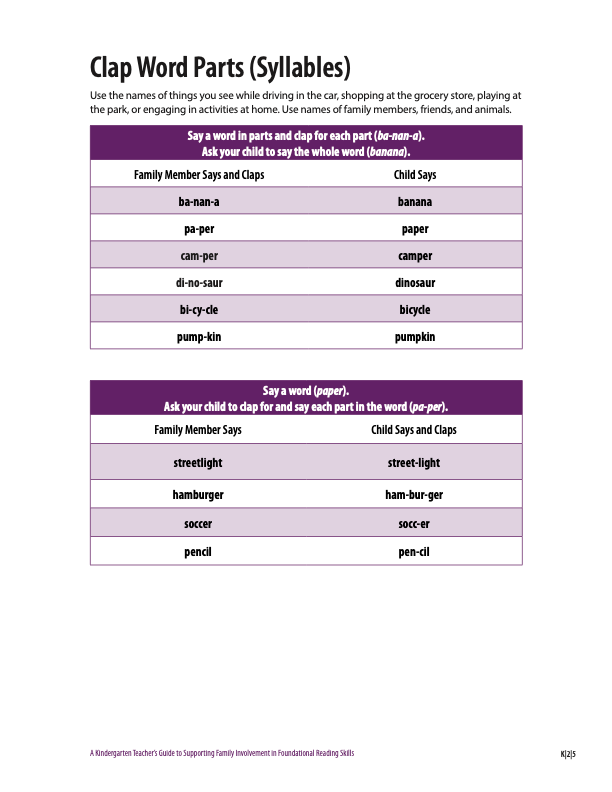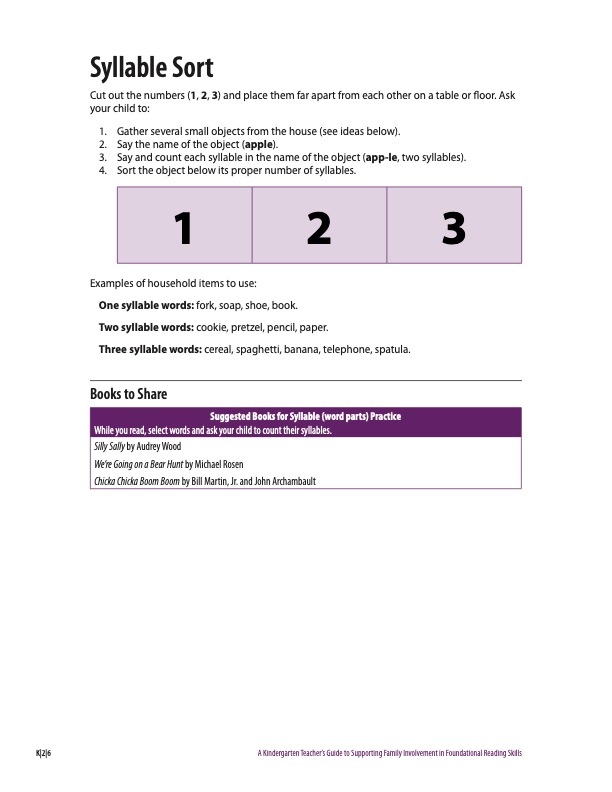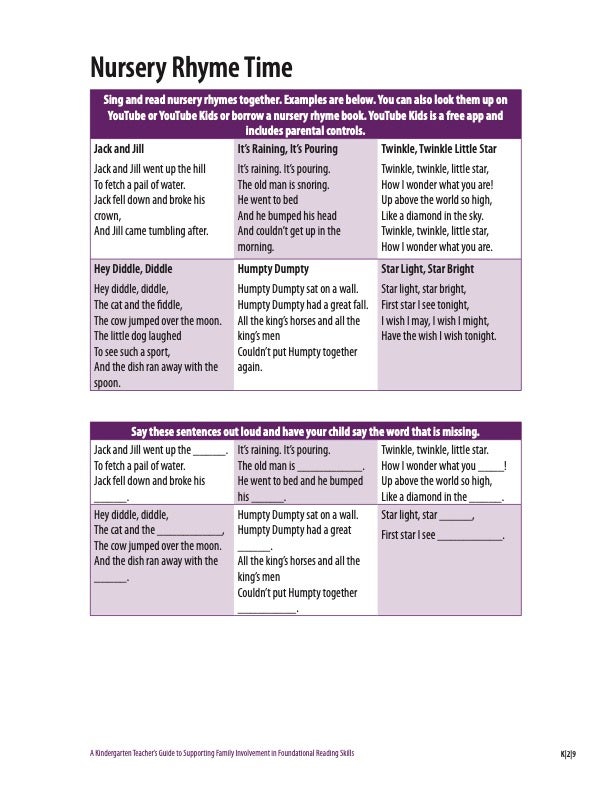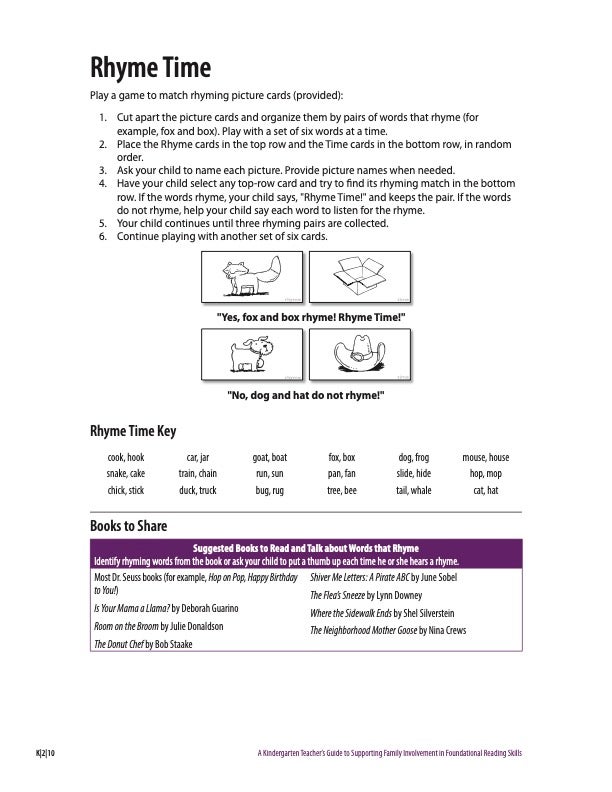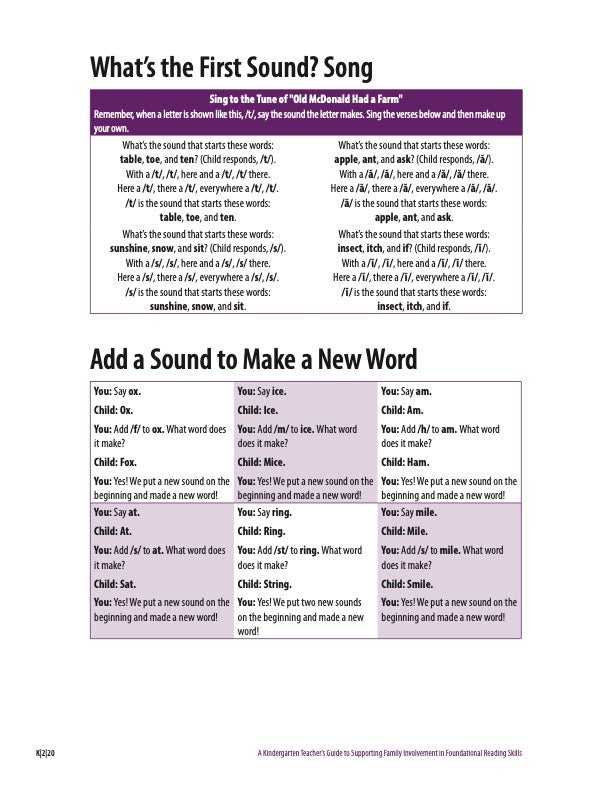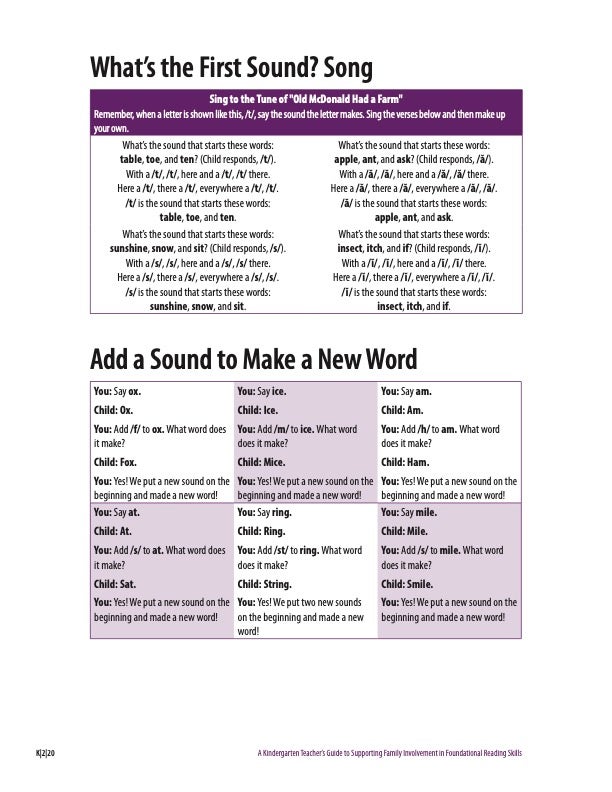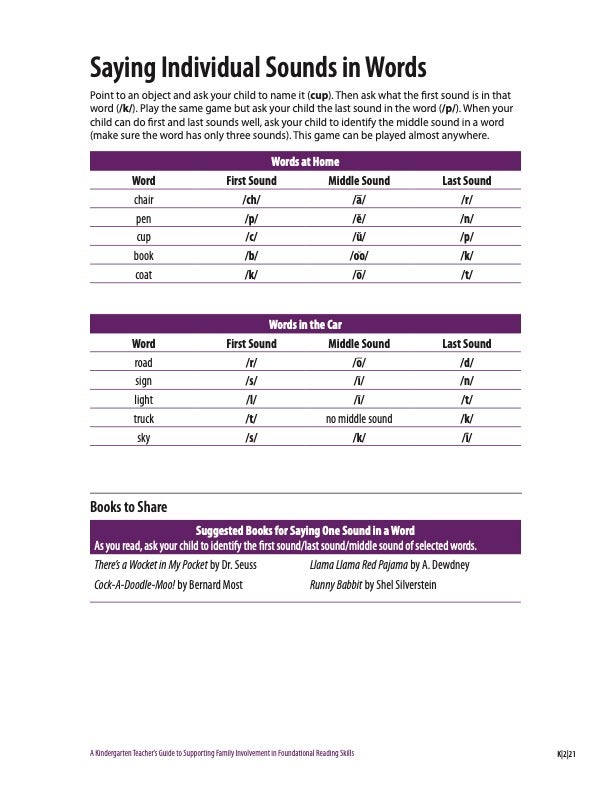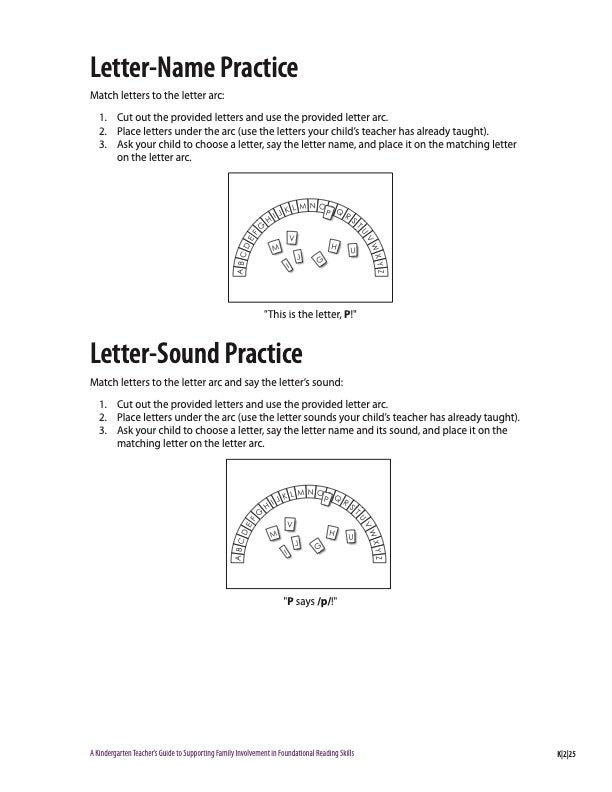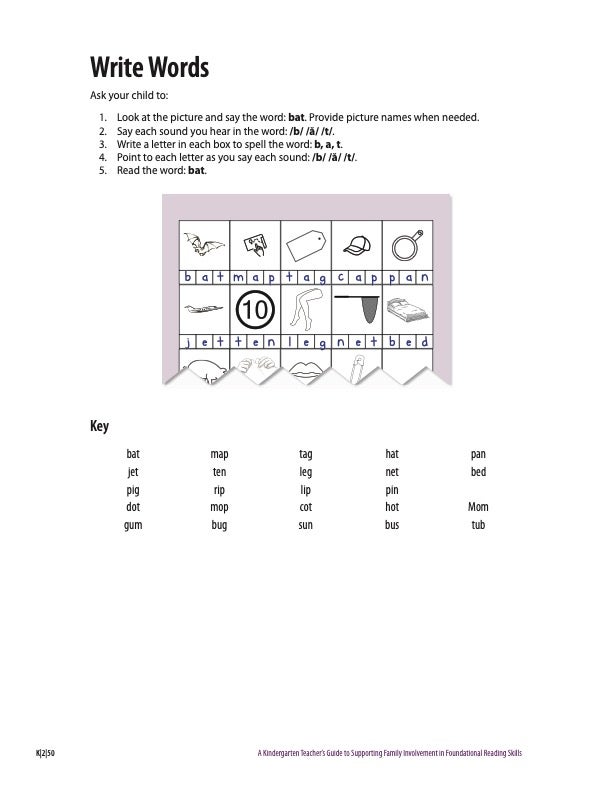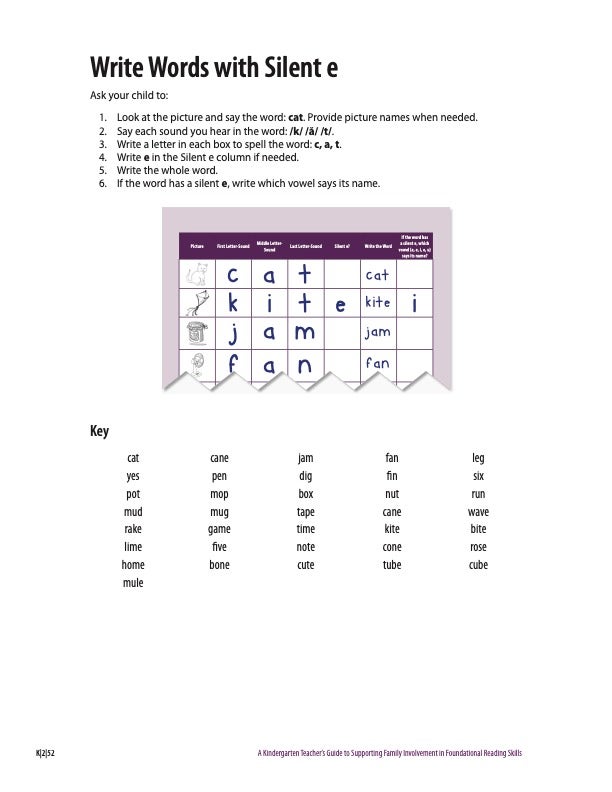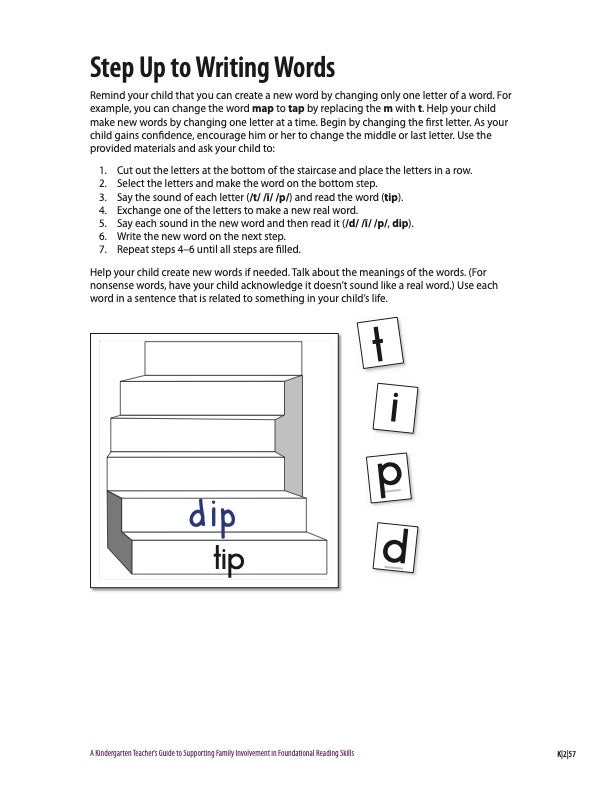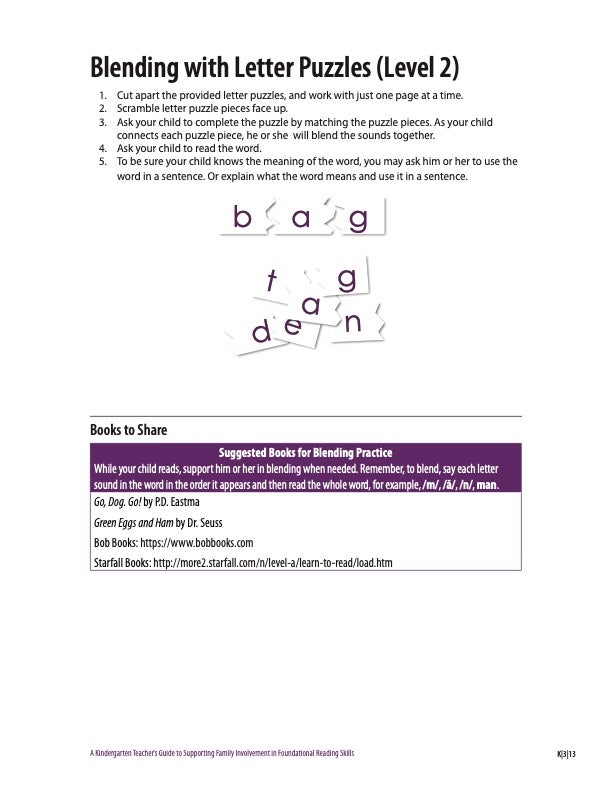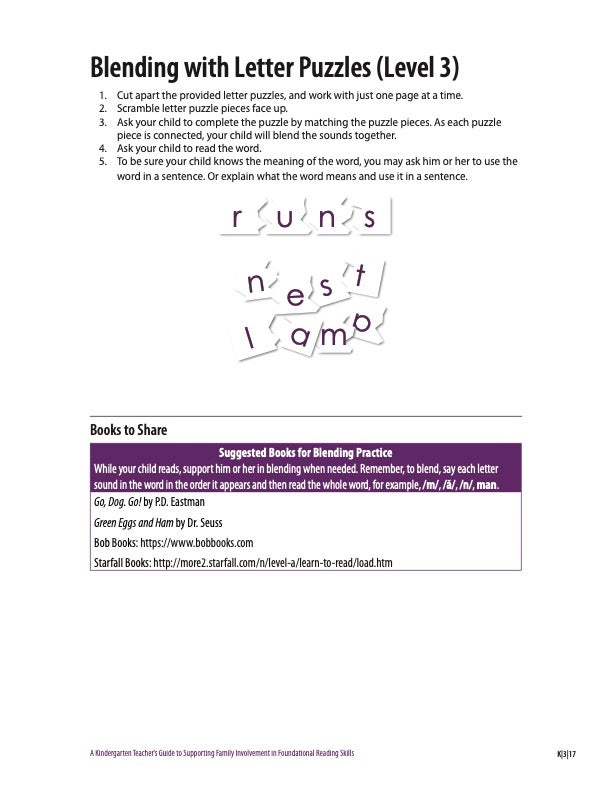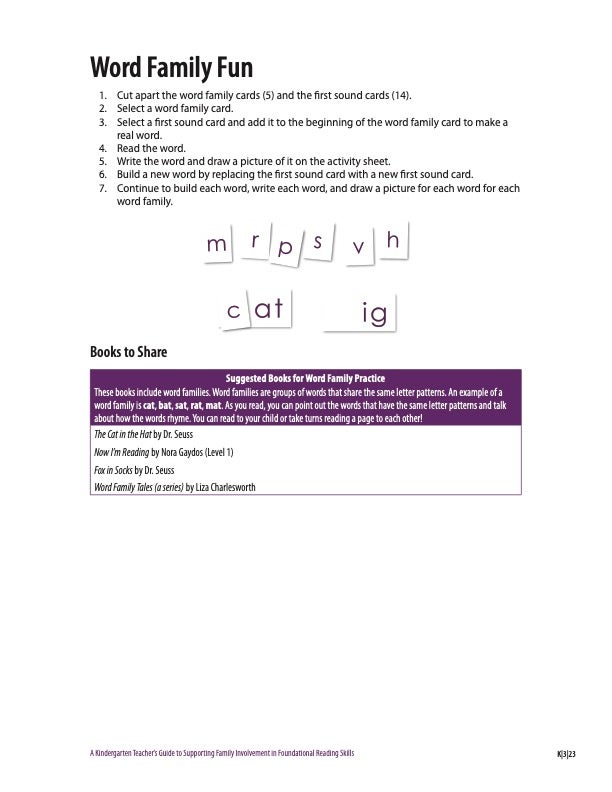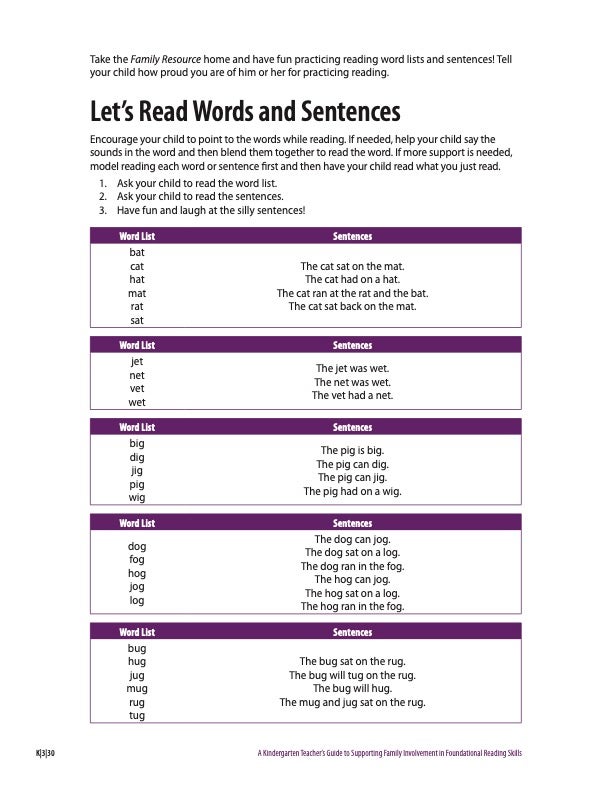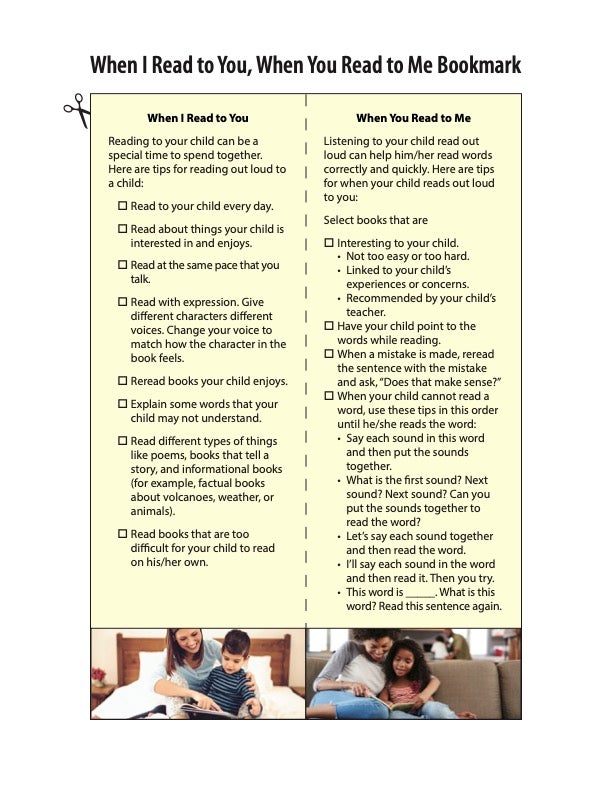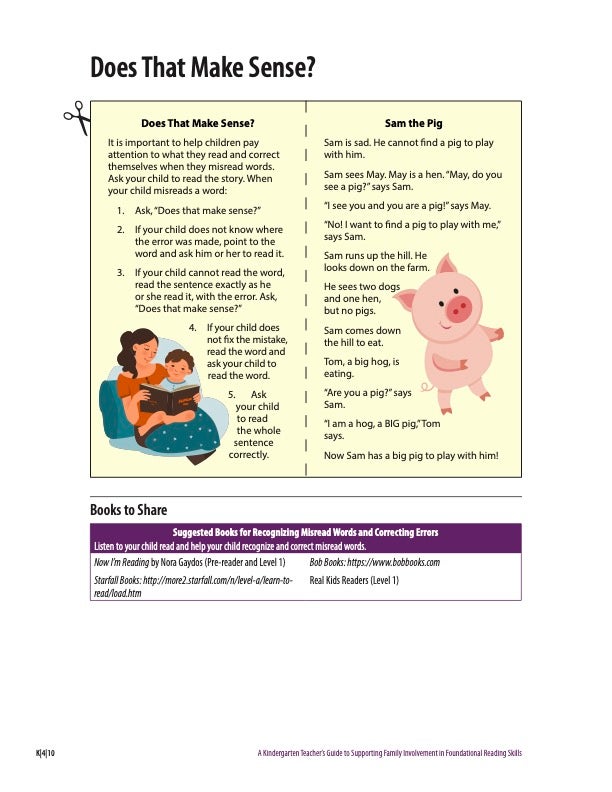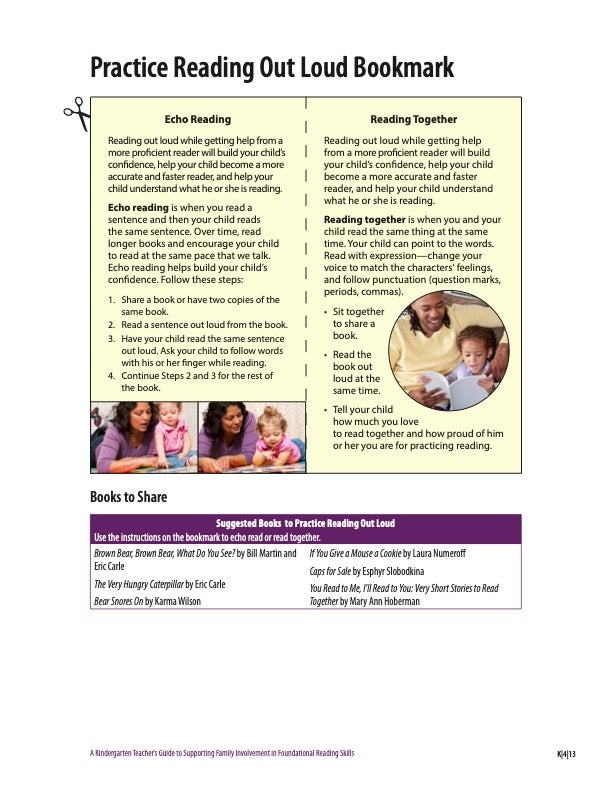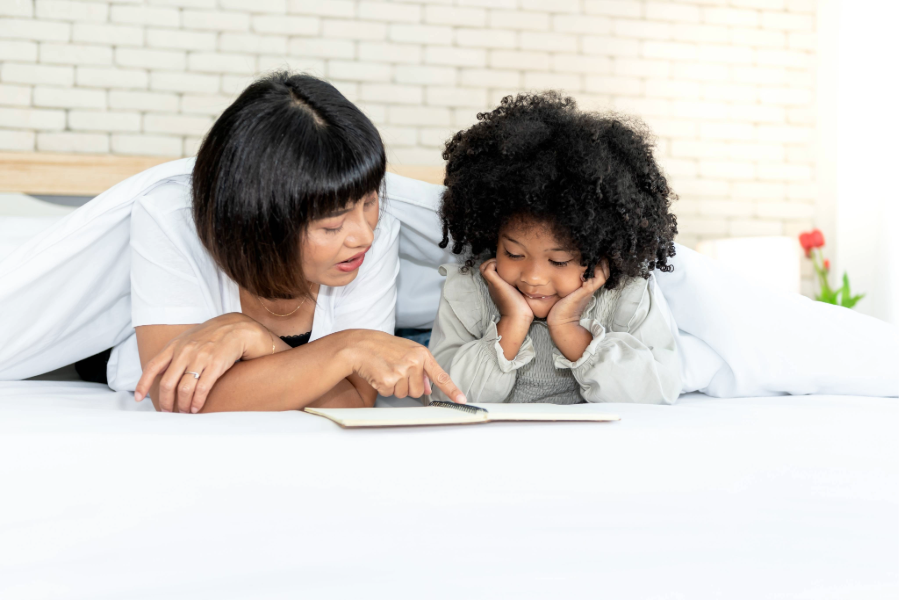
Learning to read begins at home through everyday parent-child interactions, long before children attend school. Your continued support of literacy development throughout elementary school positively affects your child's reading ability. We are pleased to provide these Family Activities with easy-to-follow instructions to help your child practice foundational reading skills. We invite you to view the short Family Videos for tips on how to use the activities to help your child grow as a reader. Using the Family Activities at home can help your child develop language, link sounds to letters, blend letters and word parts to read and write words, and read for understanding.
Kindergarten: Developing Language
Talking While You Read
Having a conversation about a book will develop your child's vocabulary and knowledge about the topic of that book. Whether you are reading a fairy tale, a picture book, an informational book, or any other text, you can engage in a discussion as you enjoy reading together.
The best books to use have detailed pictures and are about topics that are interesting to your child. You can use books from your home or borrow a book from your child's classroom library, school library, or the public library. You can also access books on laptop computers, tablets, digital reading devices, and smartphones. Websites such as Project Gutenberg provide free access to eBooks and your phone's app store includes free apps containing books for children.
To engage your child in conversation, you can use a tool called PEER: Prompt, Evaluate, Expand, and Repeat. See the Talking While You Read tri-fold and Bookmark for an example of how to use PEER.
Talking While You Read (Bear Says Thanks)
Key Points About the Video
- Mom uses some of the important words, like bare, from the book to ask questions and talk about the book.
- Mom has the Talking While You Read Bookmark in her hand to remind her about the kinds of questions to ask.
- Mom encourages her son to answer questions in complete sentences by modeling how to do so.
- Mom rereads the relevant part of the story if her son doesn't know the answer to a question.
Talking While You Read (Llama Llama and the Bully Goat)
Key Points About the Video
- Mom asks several "wh" questions (who, what, where, when, why, and how) to provide opportunities to engage in a conversation about the book.
- Mom relates the activities in the book to her daughter's life.
- Mom and daughter discuss words and their meanings ("equation", "bully").
Talking While You Read Trifold
The Talking While You Read Trifold includes an overview of how to use PEER. There is also a story with questions placed where they are most helpful to prompt your child. Remember to read the story through one time first with your child. On the second read, use PEER as you ask each question.
Talking While You Read Bookmark
You can use the Talking While You Read Bookmark to engage your child in conversation while reading any book.
Supporting Oral Language and Vocabulary Development
Oral language is the way we communicate with others through speaking and listening. Vocabulary knowledge is a crucial part of oral language and includes understanding the meaning of words, how to use them, and how to pronounce them. Children with strong oral language skills and larger vocabularies typically become better readers.
The best ways to give your child a strong foundation for learning to read are to read to, talk with, and listen to your child every day. Talk about people you know, places you go, and experiences you have together. Writing with your child also helps with oral language development. Ask questions that require more than a yes or no answer. Instead of asking, "Did you have a good day?" ask, "What was your favorite part of school today?" When you speak with your child, model speaking in complete sentences and provide details. For example, if your child points to a butterfly and says, "Butterfly!" say, "Yes, that is a monarch butterfly! Aren't her colorful wings beautiful?"
Cooking Conversations
Key Points About the Video
- Adults listen and ask open-ended questions to extend the conversation.
- Adults correct children, as needed, and encourage complete sentences.
- Adults ask children to read notes written on napkins to engage them in understanding written messages.
Dinner Table Talk
Key Points About the Video
- Children have fun baking cupcakes and talking about what they are doing.
- Caretaker fully involves the children in reading the recipe, gathering ingredients, and making the cupcakes while talking about what they are doing.
- Caretaker asks several questions and encourages both children to engage in the conversation.
Talking and Writing in the Kitchen
Use these questions, activities, and conversation starters to have fun while you talk and write in the kitchen.
Grocery Shop Talk
Use this resource to make a grocery list with your child. Ask your child questions and engage in conversations while you grocery shop together.
Kindergarten: Linking Sounds to Letters
Sounds in Words: Syllables
Being aware of sounds in words is very important to reading. This awareness allows children to break apart words orally and use sounds to learn to read and write words. They demonstrate their knowledge using their speaking and listening skills.
You can help your child develop an awareness of sounds in spoken words. Singing silly songs and making up silly words or poems are ways to enhance your child's awareness of sounds. You can make up silly sentences where most of the words begin with the same sound: Leo the lion liked to lick a lot of lollipops!
There are many types of different sounds in words. One skill is separating words into syllables, or parts, like knowing that the word folder has two syllables, or parts: fold-er. And the word computer has three syllables or parts: com-pu-ter. Being able to separate words into syllables will help children break a word into parts to help read and spell words.
Syllable Sort
Key Points About the Video
- Mom explains that a syllable is a word part and provides an example.
- Mom shows her son how to play the game by providing examples.
- Mom encourages her son to clap the word parts when he isn't sure of how many syllables are in the word banana.
Clap Word Parts (Syllables)
Help your child identify syllables in spoken words.
Syllable Sort
Help your child identify the number of syllables in spoken words.
Read Aloud and Syllable Practice (Silly Sally)
Key Points About the Video
- Mom selects a word and asks her son to clap the parts, or syllables, of the word.
- Mom selects words with different numbers of syllables, such as two or three, to give her son several times to practice counting syllables.
- A few times, Mom asks her son to describe what a word means and repeats his answer in a complete sentence to help build oral language skills.
- Mom is enthusiastic, so sharing the book is enjoyable.
Books to Share
When reading to your child, select some words from the book and have your child determine how many syllables are in those words. Suggested books to read to your child:
- Silly Sally by Audrey Wood
- We're Going on a Bear Hunt by Michael Rosen
- Chicka Chicka Boom Boom by Bill Martin, Jr. and John Archambault
Sounds in Words: Rhyme
There are many different types of sounds in words. For example, rhyming words represent a type of sound relationship between words. Children need to have the ability to recognize when words rhyme. Words rhyme when they have the same ending sound. For example, blue and shoe rhyme and moon and spoon rhyme. When children recognize words that rhyme and can say a word that rhymes with a word they are given, they can use known words to read new words—for example, they can use the known word fall to help read the unfamiliar word wall.
RHYME TIME
Key Points About the Video
- At the beginning, Mom describes what a rhyme is and shows her son how to play the game.
- Throughout the game, Mom describes the meanings of words, like random and pot.
- Mom explains why words rhyme or don't rhyme
NURSERY RHYME TIME
Help your child practice rhyming.
RHYME TIME
Help your child match rhyming words.
Read Aloud and RHYME (GREEN EGGS AND HAM)
Key Points About the Video
- Mom pauses at the end of sentences and encourages her son to say the rhyming word.
- Mom reads with expression to model good reading.
-
Mom uses the word persistent and describes what it means to help build vocabulary.
Books to Share
A list of suggested books that you can read to your child to practice listening for words that rhyme.
- Most Dr. Seuss books (for example, Hop on Pop, Happy Birthday to You!)
- Is Your Mama a Llama? by Deborah Guarino
- Room on the Broom by Julie Donaldson
- The Donut Chef by Bob Staake
- Shiver Me Letters: A Pirate ABC by June Sobel
- The Flea's Sneeze by Lynn Downey
- Where the Sidewalk Ends by Shel Silverstein
- The Neighborhood Mother Goose by Nina Crews
Sounds in Words: Individual Sounds
Although speaking and listening may not seem related to learning to read, being aware of sounds in words is very important to reading. This awareness allows children to break apart words orally and use sounds to learn to read and write words. Children first need to become aware of sounds in words without relating those sounds to print. They demonstrate their knowledge using their speaking and listening skills.
Being able to recognize the individual sounds in words is the most important skill for learning to read that is related to sound awareness. When you see a letter between forward slashes, /s/, say the sound of that letter. If you see a letter without forward slashes, s, say the name of that letter. An example of phonemic awareness is knowing that the word cat has three separate sounds (/k/ /a/ /t/) and that the first sound in cat is /k/ and the last sound in cat is /t/. Recognizing individual sounds in a word that is spoken will eventually help children "sound out" a word when they begin to learn to read simple words. For example, a child who can hear three separate sounds in sat, /s/ /a/ /t/, can then link a letter to each sound, s a t, and read the word sat.
It is also helpful if children can identify beginning and ending sounds in a word. For example, in the word cat, the beginning sound is /k/ and the ending sound is /at/. In school, we may talk about word families. Word families are groups of words that have the same endings. For example, bat, cat, and sat are all in the same word family.
Add a sound to Make a New Word
Key Points About the Video
- Mom explains how to play the game and is enthusiastic.
- Since this a listening game, Mom makes sure her son doesn't look at the paper.
- When her son does not say string, Mom helps by saying each part, /st/ /ring/, and then he is able to say string.
What's the First Sound? Song
Help your child practice listening for the first sound in a spoken word.
Add a Sound to Make a New Word
Help your child practice adding a sound to a spoken word to create a new word.
SAYING INDIVIDUAL SOUNDS IN WORDS
Key Points About the Video
- Mom explains how to play the game and is enthusiastic.
- This is a listening activity, so her son does not look at any letters or words.
- When her son says the letter name, C, instead of the letter sound, /k/, Mom tells him that he would be right if he were spelling the word, but for now, they are just listening to the sounds in words.
Saying Individual Sounds in Words
Help your child practice identifying the first, middle, and last sound in a word.
Read Aloud and Individual Sounds in Words (There's a Wocket in My Pocket)
Key Points About the Video
- Mom explains that the author changed the first sound in words to make up nonsense, or silly, words.
- Mom knows her son isn't familiar with the word sofa, so they talk about what it means.
- Mom has her son repeat some of the words like shelf/zelf and bottle/yottle. This allows him to focus on the first sound that was changed so he not only hears the sounds but says them, too.
Books to Share
A list of suggested books that you can read to your child. Ask your child to identify the first, last, and middle sound of selected words.
- There's a Wocket in My Pocket by Dr. Seuss
- Cock-A-Doodle-Moo! by Bernard Most
- Llama Llama Red Pajama by A. Dewdney
- Runny Babbit by Shel Silverstein
Letter Names and Letter Sounds
It is important for children to know letter names and letter sounds.
- Letter-name knowledge is recognizing and naming letters. An example of recognizing letters is when you show a child the letters N, A, and S and ask which letter is S, the child points to the S. An example of naming letters is when a child looks at the letter M and orally names that letter.
- Letter-sound knowledge is demonstrated when a child can look at a letter in print and tell you the sound it represents. For example, if you point to the letter F and ask, "What sounds does this letter make?" the child will say, "/f/."
There are many ways to support your child's knowledge of letter names and letter sounds. For example, you can look for a specific letter in a book or in a newspaper and then ask your child the sound that letter represents. You can point out letters on signs while in the car. You can sing the alphabet song while getting ready for school or doing chores at home. You can have your child identify specific letters in a magazine and then practice writing the letters.
Letter-Naming Practice Using a Letter Arc
Key Points About the Video
- Dad explains the game and does the first one as an example.
- After his son identifies the letter, Dad makes it a bit harder by asking for a word that begins with that letter.
- When his son does not find f right away on the letter arc, Dad helps by saying, "E, F,…"
Letter-Sound Practice Using a Letter Arc
Key Points About the Video
- Dad explains the game and does the first one as an example.
- After his son identifies the letter sound, Dad asks him to say a word that begins with that letter sound.
- Dad hugs his son when his son says hug begins with /h/.
Letter-Name and Letter-Sound Practice
Help your child practice naming letters and saying the sound for each letter.
Short-Vowel Practice
Key Points About the Video
- Mom explains the game and does the first one as an example.
- Mom reminds her son that it sometimes helps to say each sound in the word to find the middle sound.
- When her son thinks the middle sound in doll is represented by a, Mom reminds him that a says /a/ and asks which letter says /o/.
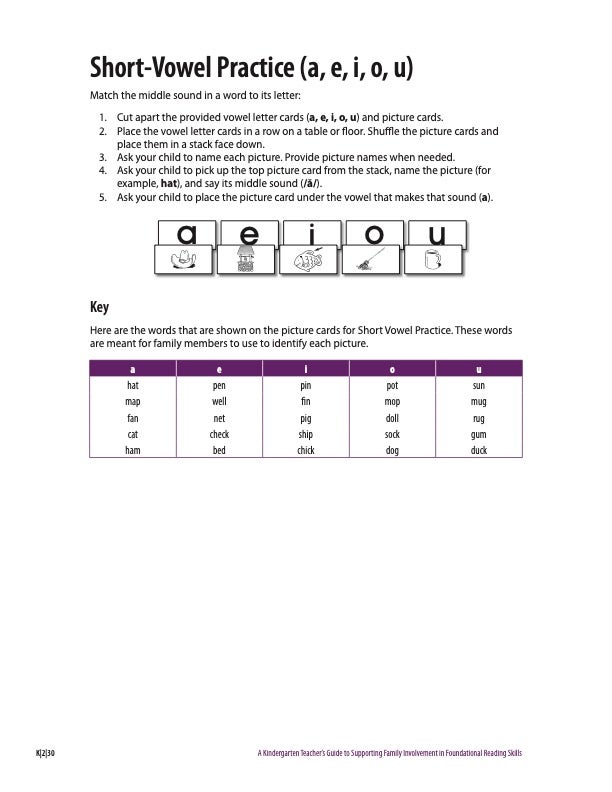
Short-Vowel Practice (A, E, I, O, U)
Help your child practice short-vowel sounds.
Letter-Sound Writing (Humpty Dumpty)
Key Points About the Video
- This activity can be done with any type of print media—even a newspaper, a magazine, or junk mail!
- Mom points to a sentence and says, "Check this sentence!" after her son misses circling a target letter.
- Her son practices writing the uppercase and lowercase letter that he circled.
- Mom gives her son a high five and tells him how hard he worked!
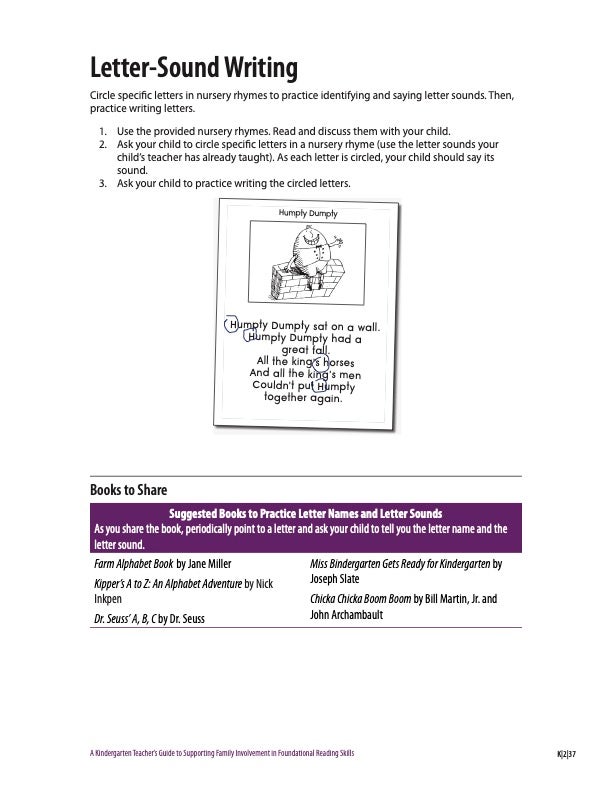
Letter- Sound Writing
Help your child practice letter sounds and writing letters.
Books to Share
A list of suggested books that you can read to your child. Point to a letter and ask your child to identify the letter name and the letter sound.
- Farm Alphabet Book by Jane Miller
- Kipper's A to Z: An Alphabet Adventure by Nick Inkpen
- Dr. Seuss' A, B, C by Dr. Seuss
- Miss Bindergarten Gets Ready for Kindergarten by Joseph Slate
- Chicka Chicka Boom Boom by Bill Martin, Jr. and John Archambault
Linking Sounds to Letters
An important step in learning to read is being able to connect how words are separated into individual sounds with knowledge of how letters relate to sounds. For example, being able to hear the individual sounds in the word sat, /s/ /a/ /t/, and knowing that s represents /s/, a represents /a/, and t represents /t/. Word-building activities can be used to support your child's learning to read and spell.
Step Up to Spelling Words
Key Points About the Video
- Mom uses a word in a sentence to help her daughter understand the meaning of the word.
- When her daughter mixes up b and d, Mom helps her use a strategy of making a b and a d with her hands in the shape of a bed.
- Mom consistently makes positive comments ("You are so smart!") and gestures (high fives) to encourage her daughter
Write Words
Help your child practice saying each sound in a word and writing that word.
Write Words with a Silent E
Help your child say each sound in a word, write the word, and determine if the vowel says its name or not.
Step Up to Writing Words
Key Points About the Video
- Mom asks her son to say each sound as he writes the words.
- When her son reads Pete for pet, Mom points to each letter beginning with P and says each sound with him.
- Mom asks her son to explain how he changed bet to set.
- Mom tells her son how proud she is of him for building words, reading words, and writing words.
Step Up to Writing Words
Help your child practice saying each sound in a word, reading the word, changing one letter in the word to make a new word, and writing the word.
Kindergarten: Blending Letters, Recognizing and Reading Words
Blending Words
Help your child blend letters to read words and recognize common word parts and words, and encourage them to write words.
Blending is the ability to put sounds together to read a word. To read a word, children must know the sounds the letters represent in the word and be able to blend those sounds to come up with the correct word. For example, after children know the letter sounds /f/ for f, /a/ for a, and /n/ for n, they learn to blend those sounds together to read the whole word. When they see the word fan, they are able to say,"/f/, /a/, /n/, fan." We call this, blending words.
The Family Resource includes three activities, organized from easier to more difficult: Levels 1, 2, and 3. The Family Resource also includes recommended books that you can read with your child. These books are made up of simple words that your child can practice blending with your help. Maybe take turns reading a page to each other!
Letter puzzles
Key Points About the Video
- Dad encourages his son to say each sound as he puts the puzzle together and then blends the sounds to read the word.
- Dad has a positive attitude and tells his son that he is doing a good job.
Blending with Letter Puzzles (Level 1)
Help your child put together (blend) letter sounds and read three letter words (fan, not, sun).
Blending with Letter Puzzles (Level 2)
Help your child put together (blend) letter sounds and read three letter words (bag, jet, pin).
Blending with Letter Puzzles (Level 3)
Help your child put together (blend) letter sounds and read four letter words (soft, nest, lamp).
Word Families
A word family is a group of words that share the same letter pattern. Look at the first list in the table below. Notice how each word has the same letter pattern, –at at the end of it? Understanding word families can help children read and spell many words. By learning just one letter pattern, like –at, your child can learn many words at the same time!
Look at the –an word family. Notice how each word has the same letter pattern,–an, at the end of it? Look at the –ig word family the table below. Notice how each word has the same letter pattern, –ig, at the end of it?
| -at | -an | -ig |
| cat | can | pig |
| sat | ran | wig |
| bat | man | dig |
| rat | fan | big |
| mat | pan | rig |
Word Family Fun
Key Points About the Video
- Dad makes sure that his son reads the word family –ig, before beginning the game.
- Dad encourages his son to use each word in a sentence to make sure that his son understands what it means.
Word Family Fun
Help your child build and read words using word families (_at, _ig, _ug).
Books to Share
A list of suggested books that include word families that you can share with your child.
- The Cat in the Hat by Dr. Seuss
- Now I'm Reading by Nora Gaydos (Level 1)
- Fox in Socks by Dr. Seuss
- Word Family Tales (a series) by Liza Charlesworth
Decodable Words
Once children know letter sounds, such as the letter s says /s/, and how to blend, they can read many words! Blending is the ability to put sounds together to read a word. For example, when children see the word sun, they are able to say, "/s/, /u/, /n/, sun."
There are many ways to support your child in reading words. For example, provide opportunities for your child to practice reading words in a list or on flashcards. It is also important for children to practice reading words in sentences and stories.
LET'S READ WORDS AND SENTENCES
Key Points About the Video
- Dad encourages his son to point to the words as his son reads them.
- Dad and son have fun and laugh at the silly sentences.
Let's Read Words and Sentences
Help your child read a list of words and then read those words in silly sentences.
High-Frequency Words
High-frequency word are words that appear frequently in books. Examples of high-frequency words are the, was, very, up. It is important that children learn to read high-frequency words automatically. When a child doesn't hesitate in reading a word and pronounces it correctly, then he or she knows the word automatically. To become good readers, children must be able to read high-frequency words automatically.
There are many activities that families can do to help their children read high-frequency words automatically. For example, use the provided high-frequency word cards as flash cards and time your child as he or she reads a stack of them. You can place words that were challenging for your child in a separate pile so you know which words need more practice. The goal is to read more words correctly in less time each time you engage in the activity. Practice is the key. The more your child reads and writes high-frequency words, the better he or she will get at reading them automatically.
MEMORY USING HIGH-FREQUENCY
Key Points About the Video
- Mom explains the game first and encourages her son to read each word as he turns over the card.
- Mom uses high-frequency words in sentences to help build vocabulary.
- Mom explains the meanings of two and to and where and wear.
- Mom asks her son to read the words even when it is her turn.
- Mom uses the memory cards as flashcards to give her son more practice.
High-Frequency Words Memory Game
Help your child practice high-frequency words (play, one, what) while playing memory.
Challenging and Important Words
Sometimes children want to read books that have words that are challenging to read but that are important for understanding what they read. For example, many children love to learn about dinosaurs but would have a hard time reading about dinosaurs because the words are too challenging. Tyrannosaurus rex would be considered challenging to read but are important words in a book about dinosaurs. These words may be challenging because the child either has not learned the sound-spelling pattern contained in the word or the word contains irregular sound-spelling patterns as in the words pigeon or villain.
Just because a book contains challenging words, it doesn't mean that you can't read it with your child. Before reading a book with your child, skim it to see if there are any challenging and important words. Select three such words that appear most frequently in the book. Introduce the words to your child before you read the book. Point to each word in the book and tell your child how to pronounce it and what it means. Ask your child to point to the word and say it.
CHALLENGING AND IMPORTANT WORDS (I WANT TO BE A VET)
Key Points About the Video
- Mom points at the word veterinarian and asks her son to repeat it. They talk about the meaning of veterinarian.
- Mom selects three challenging words, examined, injured, and clever, to discuss with her son before they read the book. She shows him each word in the book, asks him to say it, and explains its meaning.
- Mom points out the challenging words and reviews their meanings while she reads to her son.
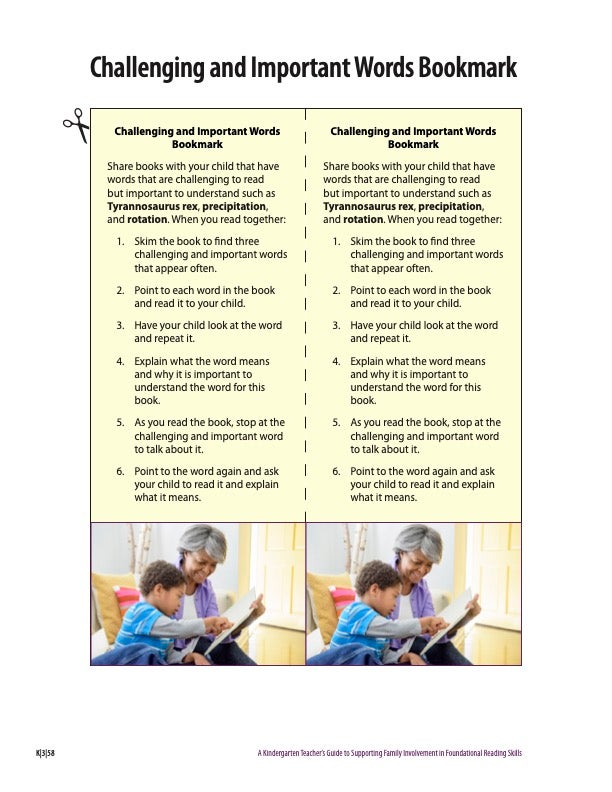
Challenging and Important Words Bookmark
Follow the steps on this bookmark to discuss challenging and important words with your child as you read books together.
Books to Share
A list of suggested science books that include challenging and important words to read with your child.
- Chameleon, Chameleon by Joy Cowley
- On Earth by Brian Karas
- Tyrannosaurus Rex by A.L. Wegwerth
- About Fish: A Guide for Children by Cathryn Sill
- The Water Cycle by Rebecca Olien
Kindergarten: Reading for Understanding
Accurate and Efficient Word Identification
Support your child in reading accurately, at a conversational pace, and with expression so they understand what they read.
As your child learns to read, it won't be long before he or she is reading sentences, paragraphs, and books! As your child practices reading out loud, it is important to help him or her read words accurately and quickly. When children read words accurately, it helps them understand what they are reading, and as children practice reading, they read words more efficiently by increasing accuracy and rate. When children can read words correctly and fairly quickly, they can focus their attention on understanding what they are reading instead of trying to identify each word.
There are two important things families can do to help their child read words correctly and quickly.
- Read out loud to your child every day! Reading to your child can be a special time to spend together. It will show him or her that reading is important and fun! Reading aloud will help your child understand what reading should sound like and provides a model of how to read words accurately and with expression. Reading with the right expression means that you are talking like the characters in the book—your voice sounds excited when the character is excited or sad when the character is sad.
- Encourage and help your child as he or she reads out loud. You might need to help your child when he or she comes to a word that is difficult to read. You might provide a reminder by saying, "Let's say each sound in this word and then put the sounds together to read it." Any reminder that encourages your child to use what he or she already knows to figure out the word can be helpful. Sometimes, showing your child how to say each sound and then reading the word may be helpful. As you help your child, remember to be patient because reading is a new skill that takes a lot of practice. Be sure to let your child know that you are proud of his or her progress! Providing support and encouragement will help your child improve in reading and become an independent reader.
When choosing books for your child to read out loud, select books that are of interest to your child, are not too easy or too hard, and are linked to his or her experiences or concerns. For example, if your child is interested in cars or is afraid of the dark, it can be helpful to select books on those topics.
When I Read to You (Bear Snores On)
Key Points About the Video
- Older brother reads at a conversational pace.
- Older brother reads with expression, changing his voice for each character.
- Brothers laugh at silly parts of the book.
When I Read To You (Book!)
Key Points About the Video
- Mom points out to her son the exclamation mark in the title of the book, and they talk about how to read the title, Book!
- Mom and her son talk about the meaning of the word present.
- Mom points to a picture and asks her son what he thinks it is and then restates his answer in a complete sentence: "The cat is attacking a blanket."
When You Read to Me (Cat Traps)
Key Points About the Video
- Older brother points to each word that his younger brother does not read correctly and encourages him to "sound it out."
- Older brother encourages his younger brother to point to the words as his younger brother reads and explains why it is important.
- Older brother tells his younger brother that he did a great job reading the book.
- Older brother asks his younger brother questions about the book to make sure his younger brother understood what he read.
When You Read to Me (This is a Peach)
Key Points About the Video
- Mom reads the title of the book with her daughter.
- When her daughter makes a mistake and corrects herself, Mom tells her, "I like the way you went back when you realized you didn't say the correct word here. I like the way you went back and fixed that. Nice job!"
When I Read to You, You Read to Me Bookmark
On one side of this bookmark are tips to use as you read out loud to your child. On the other side are tips for when your child reads out loud to you.
Books to Share
Suggested science books that include challenging and important words to read with your child.
- AH HA! by Jeff Mack
- How Rocket Learned to Read by Tad Hills
- It's Time for Bed by Mem Fox
- Knuffle Bunny: A Cautionary Tale by Mo Williams
- Guess How Much I Love You by Sam McBratney
- My Name is Yoon by Helen Recorvits
- Chicka Chicka Boom Boom by Bill Martin, Jr. and John Archambault
Recognizing Misread Words and Correcting Errors
Experienced readers know when what they are reading does not make sense because they have misread a word. Once they realize that they have misread a word, experienced readers can correct their mistake. Beginning readers don't always notice when they misread a word because they don't always pay attention to what they are reading. So, it is important to show children how to recognize misread words when they read. A reader should think about what he or she is reading and decide whether it makes sense or not, that is, self-monitor. We also need to show children how to self-correct when they misread a word. The ability to self-monitor and self-correct will help children understand what they read and become better readers.
Families can help children monitor what they read and make corrections when they misread words. As you read to your child, you can provide examples of how to recognize when words are misread by "thinking out loud." You can say things like, "That didn't make sense. I'm going to read that sentence again." When your child reads to you and misreads a word, ask her to stop and see if she can correct the error. If not, reread the sentence with the missed word exactly as your child read it and ask, "Did that make sense?" If your child does not self-correct, read the word and have her reread it. Then have her read the sentence correctly.
Does That Make Sense? (Just Grandma and Me)
Key Points About the Video
- Mom points to the words as she reads them to encourage her son to pay attention to the print, not just the pictures.
- Mom asks questions and restates her son's answers in complete sentences: "It's blowing the umbrella away."
- Mom reads some words incorrectly on purpose to show her son how to think about what he is reading and correct his mistake: "I wished them off" was changed to "I washed them off."
Does That Make Sense?
Help your child pay attention to what they read and self-correct when a word is misread.
Books to Share
Suggested books for your child to read out loud to you while you help your child recognize and correct misread words.
- Now I'm Reading by Nora Gaydos (Pre-reader and Level 1)
- Starfall Books
- Bob Books
- Real Kids Readers (Level 1)
Oral Reading Practice
Oral reading practice is when children read out loud. As children read out loud, it is important to have a more proficient reader listen and offer help when needed. As children read out loud, they get better at reading words correctly, quickly, and with the right expression (fluently). Reading words quickly means reading them at the same pace at which we talk. When you read with the right expression, you understand what commas, periods, and question marks mean. Reading with expression shows that you understand what you read when, for example, your voice expresses excitement when a character is excited. When children read fluently, they can focus their attention on understanding what they read rather than trying to figure out how to read the words. The more children practice reading out loud with support, the better reader they will become!
There are many ways to support your child in oral reading practice. You can echo read and read together.
- Echo reading means that you read part of a book out loud and then your child reads the same part out loud. Thus, your child echoes what you read. As you echo read with your child, make sure that he or she follows along while you read by looking at the words as you read them. Your child should point to the words as he or she reads the same thing you read. This is to make sure your child is paying attention to the words and not just repeating what you say.
- Reading together means you and your child read the same thing out loud at the same time. When you read at the same time, make sure that your child follows along by having him or her point to each word. You can slow your pace of reading a little when you practice reading at the same time. Always offer positive encouragement, and let your child know how proud you are that he or she is practicing reading.
Echo Reading (Little Blue Truck)
Key Points About the Video
- Mom reads with expression and encourages her son to point to the words as he reads.
- Mom reminds her son to read the words, not just repeat what she reads.
- When her son struggles with the word dump, Mom points to it and says the first sound, /d/.
- Mom explains that honk is said louder than the other words because the letters in the printed word are larger than the other words
Reading Together (Buzz Said the Bee)
Key Points About the Video
- Mom points to the words as she and her son read together.
- Mom slows the pace of reading a bit but reads as fluently as possible.
- Mom describes to her son the meaning of the important words scat and weep.
Practice Reading Out Loud Bookmark
Use this bookmark as a reminder of the importance of reading every day with children. One side of the bookmark describes echo reading and the other side describes reading together.
Books to Share
A list of suggested books to echo read with your child.
- Brown Bear, Brown Bear, What Do You See? by Bill Martin and Eric Carle
- The Very Hungry Caterpillar by Eric Carle
- Bear Snores On by Karma Wilson
- If You Give a Mouse a Cookie by Laura Numeroff
- Caps for Sale by Esphyr Slobodkina
- You Read to Me, I'll Read to You: Very Short Stories to Read Together by Mary Ann Hoberman
The Family Activities were excerpted from A Kindergarten Teacher's Guide to Supporting Family Involvement in Foundational Reading Skills, which include Kindergarten Videos.


